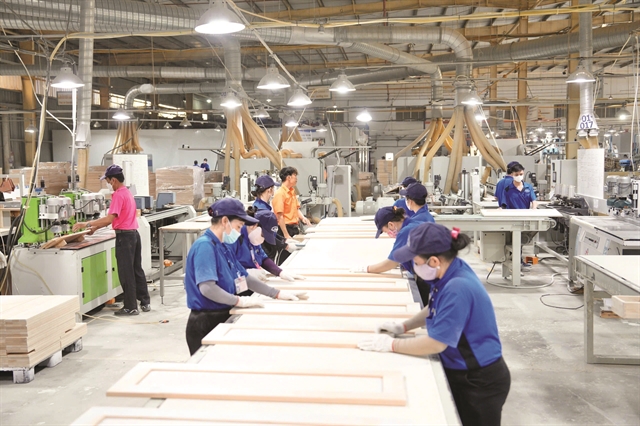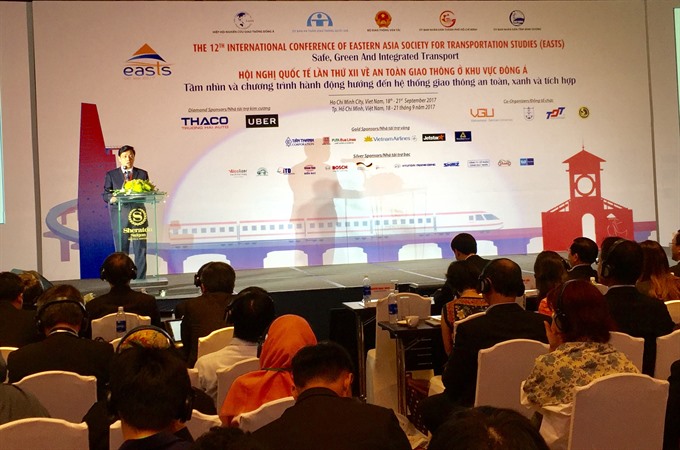 Society
Society

Việt Nam aims to improve road infrastructure to ensure traffic safety and reduce traffic congestion and the number of accidents, an official said at a meeting held yesterday in HCM City.
 |
| Around 800 local and international traffic experts and policymakers are meeting at the 12th International Conference of the Eastern Asia Society for Transportation Studies (EASTS) which opened yesterday in HCM City. VNS Photo Bồ Xuân Hiệp |
HCM CITY — Around 800 local and international traffic experts and policymakers shared vision and discussed action programmes for safe, green and integrated transport at a meeting held yesterday in HCM City.
They were taking part in the 12th International Conference of the Eastern Asia Society for Transportation Studies (EASTS).
The four-day conference focuses on a number of issues, including management of personal vehicles; application of intelligent transport systems; traffic safety for vulnerable commuters like motorbike drivers and pedestrians; public transport development; and sustainable transport development that adapts to climate change.
Speaking at the conference, Nguyễn Ngọc Đông, Deputy Minister of Transport, said Việt Nam aimed to improve road infrastructure to ensure traffic safety and reduce traffic congestion and the number of accidents.
“Developing socio-economic infrastructure is one of three expected breakthroughs in the country’s socio-economic development strategy in the 2011-20 period, in which traffic infrastructure plays an especially important role.”
Đông said Việt Nam had mobilised investment to build major projects like highways, airports and seaports, among others.
Today, at least 831 kilometres of highways are now in operation, airports have a capacity of serving 75 million passengers a year, and seaports process at least 500 million tonnes of goods a year.
In recent years, Việt Nam has carried out serious measures to reduce traffic jams and accidents with positive results, including a decrease in the number of transport accidents, deaths and injuries, according to Đông.
For instance, there were 21,568 transport accidents nationwide with 8,669 deaths and 19,280 injuries last year, a decline of 1,259 accidents, 47 deaths and 1,789 injuries, respectively, compared to the figures in 2015.
Road accidents accounted for 97.8 per cent of all accidents (66.7 per cent of which were caused by motorbikes and motorcycles and 27.07 per cent by automobiles) while 1.7 per cent were railway accidents and 0.5 per cent inland waterway accidents.
He emphasised that most traffic accidents were caused by drivers (71.6 per cent).
Dr Tetsuo Yai, president of EASTS, said that EASTS this year would share transport research results among participants as it had in past conferences.
EASTS was growing as a leading society in transportation studies in emerging and expanding Asia, he said.
The conference’s theme “safe, green and integrated transport” was chosen to recognise the crucial role of transport in the field of environment and sustainability.
“In the context of climate change, we intend to contribute to the betterment of the region and transportation through relevant research output,” he told Việt Nam News.
Challenges
According to Đông, like many developing countries in the region, the transport sector in Việt Nam is facing challenges in infrastructure and safety, while there is significant investment demand but insufficient funding and resources.
Other challenges include substantial construction costs without effective application of new technologies and poor quality of some construction works.
Assuring traffic safety at a time when traffic jams and accidents are worsening poses difficulties as well as inconsistent implementation of construction, land use and traffic planning.
There are also limitations in the management of roads with poor coordination and problems of encroachment upon safety corridors of roads.
Serious accidents involving passenger cars, container trucks and trains, among others, continue to be a cause of concern.
In large cities like HCM City and Hà Nội, the public transport system is still limited and fails to take a leading role in the urban transport system.
Participants at the conference this year will tour the Underground Metro Construction Site (metro Line No. 1), including the Bến Thành Market underground station and the Centre for an Intelligent Transport System at the HCM–Trung Lương Highway.
In addition, a similar conference with the theme “Bình Dương: Vision of a Safe Transport System, a Smart City” will be held in Bình Dương Province on Sept 21. It will focus on road safety management, responses after traffic accidents, railway safety and inland waterway safety.
Short-term and long-term solutions for sustainable transport development in the province will also be discussed.
EASTS seeks to foster and support excellence in transportation research and practice, and to stimulate professional exchange in all aspects and modes of transport among members.
EASTS was founded in 1994 as a result of a meeting held in Japan with transport experts from Asia. Members included Việt Nam, Australia, Cambodia, China, Hong Kong, Indonesia, Japan, South Korea, Malaysia, Mongolia, Myanmar, Nepal, New Zealand, the Philippines, Singapore, Taiwan and Thailand, among others.
In 2001, under the sponsorship of the Ministry of Transport, the Việt Nam Road and Bridge Association organised the 4th EASTS conference in Hà Nội. — VNS